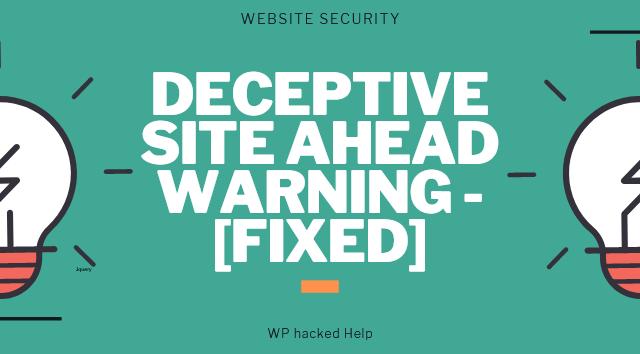WordPress Plugin for Deceptive Site Ahead: Essential Tips for Website Owners
Seeing a “Deceptive Site Ahead” warning can be a nightmare for website owners. It can drive away visitors and damage your site’s reputation. This warning pops up when Google detects harmful activity like malware or phishing. To avoid this, using a WordPress Plugin for Deceptive Site Ahead is a simple and effective way to keep your site safe and secure.
What Triggers the ‘Deceptive Site Ahead’ Warning?
The Deceptive Site Ahead warning is triggered when Google finds something suspicious or harmful on your website. This usually happens because of:
- Malware: If your site gets infected with malware, it can spread harmful software to your visitors.
- Phishing: Phishing tricks users into giving away sensitive information like passwords or credit card numbers.
- Unsafe Links: Links to dangerous websites can also cause the warning to appear.
Google constantly scans websites for these issues. When it detects them, it flags your site as unsafe to protect users. This warning can seriously affect your site’s traffic and credibility, which is why fixing these problems quickly is so important.
How a WordPress Plugin Helps
A WordPress Plugin for Deceptive Site Ahead is a powerful tool that helps protect your website from the warning and the issues that cause it. Here’s how it works:
- Prevention of Malware: The plugin scans your site for malware and removes it before it can do harm.
- Threat Scanning: It regularly checks your website for any new threats, helping you stay ahead of potential problems.
- Real-Time Alerts: If the plugin detects something suspicious, it sends you immediate alerts. This way, you can take action before the warning appears.
By using this plugin, you not only protect your visitors but also maintain your site’s reputation and search engine ranking.
Essential Tips for Choosing a WordPress Plugin
When selecting a WordPress Plugin for Deceptive Site Ahead, it’s important to consider a few key factors to ensure you pick the right one for your needs.
1. Security Features
Look for plugins that offer strong security features. Some important features to consider are:
- Malware Detection: This helps find and remove harmful software.
- Firewall: A firewall protects your site from unwanted visitors and attacks.
- Real-Time Scanning: Regular scans help catch threats before they cause issues.
2. Ease of Use
A user-friendly interface is essential. You want a plugin that’s easy to install and navigate, even if you’re not a tech expert. This will save you time and frustration.
3. Regular Updates
Security threats change all the time. Choose a plugin that offers automatic updates to keep it effective against new risks. Regular updates ensure you have the latest protection.
4. Positive Reviews
Before choosing a plugin, check its ratings and user feedback. Look for plugins with good reviews and satisfied users. This can help you avoid poor-quality plugins that might not protect your site properly.
Setting Up and Configuring Your Plugin
Once you’ve chosen the right WordPress Plugin for Deceptive Site Ahead, it’s time to set it up. Here’s how to do it step by step:
1. Installation Guide
- Go to your WordPress Dashboard: Log into your WordPress account.
- Select “Plugins”: Click on the “Plugins” option in the menu.
- Add New Plugin: Click the “Add New” button.
- Search for the Plugin: Type in the name of the plugin you want to install.
- Install and Activate: Click “Install Now,” and once it’s done, click “Activate.”
2. Key Settings for Maximum Protection
After installation, you’ll want to configure the plugin for the best results. Here are some important settings to focus on:
- Real-Time Scanning: Enable real-time scanning to catch threats as they happen.
- Alerts: Set up notifications for when the plugin detects suspicious activity. This helps you respond quickly.
- Backup Configurations: Ensure you have backup settings in place so you can restore your site if needed.
Common Mistakes to Avoid
Even with the best intentions, website owners can make mistakes that compromise their site’s security. Here are some common pitfalls to avoid:
1. Ignoring Updates
Neglecting to update your WordPress plugins can leave your site vulnerable to attacks. Security patches and improvements are released regularly, so always keep your plugins up to date.
2. Not Scheduling Regular Scans
Skipping regular scans means you might miss potential threats. Make it a habit to schedule scans to catch issues early. This simple step can save you a lot of trouble later.
3. Overlooking Backup Settings
Failing to set up regular backups is a serious mistake. If something goes wrong, having a backup means you can restore your site quickly. Set up automatic backups to keep your site safe.
Best Practices for Maintaining Site Security
To keep your website safe, it’s essential to follow some best practices. These tips will help you maintain your site’s security over time:
1. Regular Scans and Updates
Make it a routine to run scans and update your plugins regularly. This helps catch any new threats and keeps your security measures effective. Set a reminder to check for updates at least once a month.
2. Monitoring Activity
Stay alert by setting up real-time alerts. This way, you’ll be notified if any suspicious activity occurs on your site. Regularly review reports from your security plugin to identify any unusual patterns or potential threats.
3. Backups
Frequent backups are crucial for your site’s safety. Create a backup schedule that works for you, whether it’s daily, weekly, or monthly. This ensures that you always have a recent version of your site to restore if something goes wrong.
Conclusion
Website security is not just an option; it’s a necessity. Using a WordPress Plugin for Deceptive Site Ahead is one of the best ways to protect your site from threats that can harm both your visitors and your reputation. These plugins not only help prevent dangerous warnings from Google but also give you peace of mind knowing that your site is safe.





